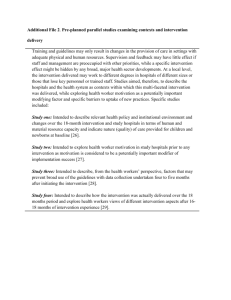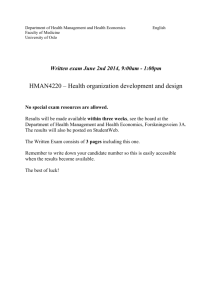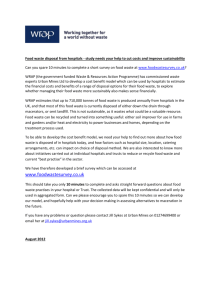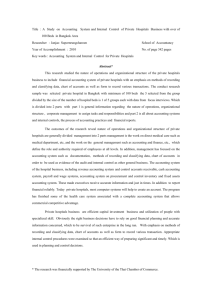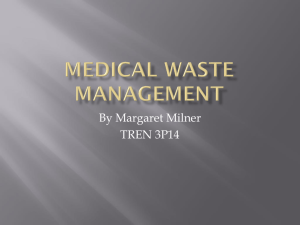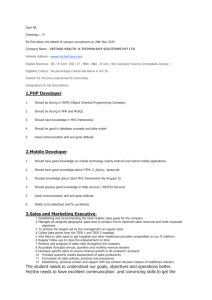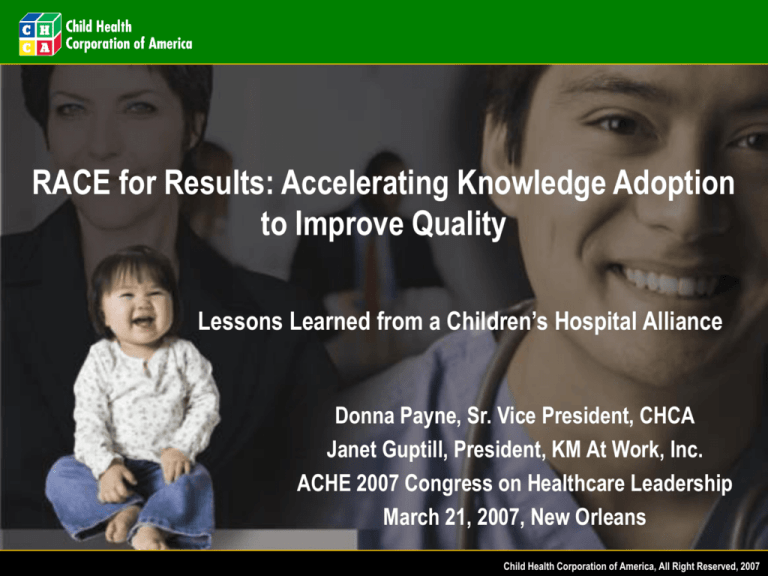
RACE for Results: Accelerating Knowledge Adoption
to Improve Quality
Lessons Learned from a Children’s Hospital Alliance
Donna Payne, Sr. Vice President, CHCA
Janet Guptill, President, KM At Work, Inc.
ACHE 2007 Congress on Healthcare Leadership
March 21, 2007, New Orleans
Child Health Corporation of America, All Right Reserved, 2007
Knowledge Transfer Improves Hospital Performance
Improving the Performance of Children’s Hospitals
Strategy Drives Approach
Informal peer networking builds a culture of sharing and collaboration
Formal collaboratives are needed to create immediate results
Systematic rewards and support are needed to spread initial results
Knowledge Transfer involves Technology, People/Process, and
Strategy
Technology enables information sharing and people directories
People processes ensure productive interaction and knowledge exchange
Strategy determines impact measures and ensures organizational momentum
CHCA Case Study Results:
42 children’s hospitals participate in 30 peer networking forums, regularly sharing improvement
tools and resources, exchanging best practices and learning from industry experts
18 children’s hospitals averted 13,478 adverse drug events (ADEs), representing $2.7 million in
net savings, and reduced PICU blood stream infections (BSIs) by 57%
More than 60 intensive care units are working to sustain and spread improvements in ADEs and
BSIs based on the initial collaboratives’ work
11/22/06
2
Knowledge Transfer Building Blocks at CHCA
Improving the Performance of Children’s Hospitals
Peer Networking
Performance
Improvement
Spread
TECHNOLOGY
Online communities
Peer group meetings
Collaboratives
C, C, c
RACE for Results
Juried annual award
PEOPLE &
PROCESS
Teleconferences
List serves
Forum directors
Special reports
Benchmarking
PDSA approach
Results reported to peers and
executives
Dedicated PI staff
Awards process with
external judges
Peer reviewed publication
Ambassador program
External published results
Real time tools and
resources
STRATEGIC
IMPACT
Individual employee
improvement in productivity
Satisfaction + individual
hospital improvement in results
Organization-wide
improvement, e.g., cost
reduction, error reduction,
safety improvement
Accelerate improvement
Safe, efficient and effective
Focus on spread
Knowledge available when
you need it
Best practices
Peer assistance
11/22/06
3
Knowledge Transfer to Improve Performance:
A Case Study
Improving the Performance of Children’s Hospitals
42 non-competing hospitals US, Canada
$14 billion combined revenue (1)
Average per member revenue of $330 million
If Fortune 500 would be ranked 142
IDN influence:
– 500,000 inpatients; 10 million outpatients (2)
– 102,000 employees (2)
– >20,000 pediatric physicians (5,162 medical specialists;1,985 surgical specialists(2))
Top 5 among U.S. health systems/IDNs
Sources: (1) Estimated from Goldman Sachs report to CHCA, July 2004; (2) Estimated from
personnel report in AHA Guide 2003/ 2004
11/22/06
4
RACE for Results: Accelerating Knowledge Adoption
to Improve Quality
Peer Networking
Performance Improvement
Spread
Child Health Corporation of America, All Right Reserved, 2007
Peer Networking:
Creating a Connected Culture
How CHCA Forums Accelerate Knowledge
Exchange and Build Connections
Child Health Corporation of America, All Right Reserved, 2007
Peer Networking Builds Loyalty
Improving the Performance of Children’s Hospitals
The Opportunity:
The combined knowledge and expertise of all the member hospitals is tapped when
a new manager comes on board
Centralized knowledge space limits brain drain due to turnover and retirements
– CEO turnover is 30% annually industry wide; higher among departmental managers
– Average hospital staff age is 50; getting new employees trained quickly is critical
Online communities among peers limits “re-inventing the wheel” each time an issue
is faced
The Relevance:
Employee satisfaction drives customer satisfaction and market share
Employee productivity drives operating cost and margin
Results:
42 children’s hospitals participate in 30 forums representing over 2600
executives/managers.
11/22/06
7
Peer Networking Forums are Highly Active
Improving the Performance of Children’s Hospitals
2006 Hospital Participation in Forums
Ambulatory
22
Materials Management
33
Cardiac
28
OR Directors
31
CFO
40
PACT
34
CHAPs
17
Patient Financial Services
21
CIO
36
Payor Contracting
33
CNO
40
Pediatric Practice Exec.
22
COO
40
Pharmacy Buyers
40
Corporate Compliance
28
Pharmacy Directors
39
Customer Service
20
Overall 2006
satisfaction:
PHIS
37
Dietary
33
Physician Relations
22
Executive Dialogue
40
5.24 of 6.0
(87%)
Quality and Safety
Leaders
42
Facilities Management
33
Radiology Directors
33
Health Information Mgmt
33
Respiratory Directors
32
Home Care
17
Risk Managers
25
Human Resources
32
SMAC
30
JCAHO
35
Social Work Community
15
Lab Directors
32
SPBD
28
11/22/06
8
Peer Networking Forums webpage
Improving the Performance of Children’s Hospitals
11/22/06
9
How does it work?
Improving the Performance of Children’s Hospitals
Internet site for Forum members only
– Exclusivity, confidentiality, knowledge of colleagues
– Dedicated staff facilitator – Supports 3-5 Forums depending on content
knowledge and required expertise
– Share documents, post weblinks, initiate discussions, find resources
Technology combined with meetings keeps the group connected
–
–
–
–
Teleconferences, webcasts, bi-annual meetings
Ad hoc conversations, focused research, group problem-solving
Rapid response to posted questions
Benchmarking and identifying variation
11/22/06
10
How can you learn from this?
Improving the Performance of Children’s Hospitals
Upgrade intranet to include 2-way communication capabilities
– Incorporate suggestion box for online idea submissions
– Utilize team e-rooms for special projects or cross-facility peer group networking
– Institute employee email system and instant intranet access to facilitate
organization-wide communication
Reinforce a culture of connectivity
– Post meeting materials and minutes online before and after
– Incorporate online learning tools where appropriate
– Exclusively utilize email and intranet site to keep employees current on
organization-wide strategies, department-specific issues, or for shift scheduling
Potential reward
– Reduces error, reduces time spent searching for solutions to common issues,
improves employee satisfaction, facilitates employee professional development
– Reinforces organizational strategy and performance goals
11/22/06
11
Performance Improvement:
The Power of Collaboratives
How CHCA Collaboratives Accelerate
Adoption
Child Health Corporation of America, All Right Reserved, 2007
Collaborative Reduces Adverse Drug Events
Improving the Performance of Children’s Hospitals
The Opportunity:
ADEs occur in 6 to 10 percent of hospitalized patients
Narcotics among highest risk for errors for children
–
–
50 percent of ADEs related to narcotics
5.2 narcotic-related ADEs for every 100 patients
The AIM Statement:
Reduce the occurrence of ADEs related to opioid and non-opioid
narcotics by 50 percent
Results:
18 children’s hospitals averted 13,478 ADEs, representing $2.7 million in
net savings (CHCA-approved methodology)
11/22/06
13
Collaborative Reduces Adverse Drug Events
Improving the Performance of Children’s Hospitals
16 teams (89%) had a reduction in ADE rate
Atlanta
Birmingham
– Average among teams with a reduction: 64%
Buffalo
reduction
Cincinnati
– Average for all teams: 49% reduction
Columbus
Corpus Christi
11 teams (61%) had at least a 50% reduction in ADE rate
Dayton
0%
Fort Worth
Kansas City
-20%
Miami
Nashville
-40%
New Orleans
Goal
-60%
New York/Morgan-Stanley
Avg.
New York/Komansky Center
-80%
Orange
Palo Alto
-100%
CHCA Hospitals with reduction in ADE rate
Pittsburgh
St. Petersburg
o
m
N
ew bus
Yo
rk
Pi
tts B
bu
rg
h
Pa
lo
Al
to
Ft
W
C
or
or
pu
th
s
C
h
N
ew rist
i
O
rle
an
s
At
l
a
Ka
nt
a
ns
as
Ci
ty
N
as
hv
ille
C
in
c
in
St
Pe nat
i
te
rs
bu
Bi
rg
rm
in
gh
am
D
ay
to
n
ng
e
ffa
l
ol
u
C
Bu
O
ra
Av
er
ag
e
% change
BETTER
Hospital Teams:
11/22/06
14
Collaborative Reduces Adverse Drug Events
Improving the Performance of Children’s Hospitals
Developed new tools and knowledge to detect
adverse events
3 new trigger tools have effectively prevented
adverse events
– 15 pediatric triggers improved detection of ADEs by 22x
– 8 triggers increased narcotic ADE detection
– 16 neonatal triggers improved detection of ADEs by 12x
11/22/06
15
Adverse Drug Event Collaborative webpage
Improving the Performance of Children’s Hospitals
Add ADE Collaborative screenshot
11/22/06
16
Collaborative Reduces Blood Stream Infections
Improving the Performance of Children’s Hospitals
The Opportunity:
Catheter-associated blood stream infections (BSIs) are a serious threat to
patients’ safety
Areas of highest risk for BSIs include PICU, NICU, CICU, and
Hematology/Oncology
The AIM Statement:
Reach zero tolerance for BSIs among targeted patient populations
Results:
18 children’s hospitals reduced BSIs in the PICU by 57%
Hospitals prevented 112 BSIs resulting in nearly $1 million in estimated net
cost savings
Accelerating a goal: One PICU has been BSI free for 563 days as of
9/20/06
11/22/06
17
Collaborative Reduces Blood Stream Infections
Improving the Performance of Children’s Hospitals
Includes only hospitals with a reduction in Catheter-related BSI rate
0
*
-60
*
GOAL:
50% reduction
-80
*
er
ag
e
D
ay
to
n
At
la
nt
a
Ak
ro
n
O
m
Lo
ah
s
An a
g
Sa eles
n
Di
eg
o
Ft
W
N
ew ort
O h
rle
an
Ph s
oe
ni
x
M
ia
m
i
Bu
ffa
l
O o
r
a
N
ew ng
Yo e
rk
-A
C
ol
um
P i bus
tts
M
bu
em
rg
h
ph
B
is
os
-L
t
eB on
on
he
u
N
as r
hv
ille
-100
Better
-40
Av
% change
-20
18 teams (62%) achieved a reduction in BSI rate
– Average among teams with a reduction: 57% reduction
– Average for all teams: 31% reduction
11 teams (38%) achieved a 50% reduction in BSI rate
*Statistically significant improvement p<0.05
11/22/06
18
Blood Stream Infection Collaborative webpage
Improving the Performance of Children’s Hospitals
11/22/06
19
Surgical Infection Prevention Collaborative
Improving the Performance of Children’s Hospitals
The Opportunity:
Surgical Site Infections (SSIs) are third most frequently reported
hospital acquired infection
– 16 percent of all nosocomial infections
– Among surgical patients, 38 percent of all infections,
77 percent of deaths for patients with SSI
– SSIs increases LOS 7 to 10 days
In children:
–
–
–
–
One of the most common indications for operative intervention
40 to 60 percent of SSIs are preventable
>200,000 surgical procedures (n=34 hospitals)
Inappropriate use of prophylactic antibiotic = 25 to 50 percent of operations
11/22/06
Source: CDC’s National Nosocomial Infections Surveillance (NNIS)
20
Surgical Infection Prevention Collaborative
Improving the Performance of Children’s Hospitals
The AIM Statement:
Appropriate use of prophylactic antibiotics as follows:
– Selection: 95 percent of procedures will be accompanied by prophylactic antibiotics
consistent with hospital guidelines
– Start time: 95 percent of procedures will have antibiotic prophylaxis initiated 30-60
minutes before the incision
– Re-dosing: 95 percent of procedures for which re-dosing is indicated will receive a 2nd
dose of intraoperative antibiotics consistent with hospital guidelines
– Post-operative discontinuation: 95 percent of procedures will have prophylactic
antibiotics discontinued within 24 hours after surgery
Skin preparation performed as follows:
– Hair removal: 95 percent compliance with appropriate hair removal (for those patients
undergoing hair removal)
– Skin antisepsis: 95 percent compliance with appropriate skin antisepsis
SIP bundle compliance: 95 percent of procedures will be accompanied by appropriate
prophylactic antibiotic use ( selection, timing, intraoperative re-dosing if necessary and postoperative discontinuation) and appropriate hair removal
Reduce Surgical Site Infection (SSI) by 50 percent
11/22/06
21
Surgical Infection Prevention Collaborative
Improving the Performance of Children’s Hospitals
11/22/06
22
Surgical Infection Prevention Collaborative
Improving the Performance of Children’s Hospitals
The Power of Collaboration:
28 Hospitals set Goal to reduce
Surgical Site Infections by 50%
11 outcome, process and
balancing measures
On-line tracking and reporting
(July 2006-2007)
Final Report: September 2007
Hospital Teams:
Akron
Atlanta
Birmingham
Boston
Chicago
Columbus
Corpus Christi
Dallas
Detroit
Fort Worth
Hartford
Houston
Kansas City
Los Angeles
Memphis- Le
Bonheur
Memphis - St Jude
Miami
Milwaukee
Nashville
New Orleans
New York
Palo Alto
Philadelphia
Phoenix
Pittsburgh
Seattle
St. Petersburg
Washington, DC
11/22/06
23
How does it work?
Improving the Performance of Children’s Hospitals
Dedicated Performance Improvement staff and resources
–
–
–
–
Trained in IHI improvement methodology
Hospitals agree to share results, post data and publish results
Use industry and hospital expert panels to validate clinical direction
Combine research and rapid cycle - essential for academic engagement
Technology tools and partners integral to success
– Knowledge repository available real time
• improvements, tool kits, lessons learned, comparative data, audios of webcasts
and lessons learned
– Strategic partners essential to spreading results and gaining credibility
• AHRQ Partnership for Quality Grant helped fund participation and training for all 42
hospitals
• Data-sharing agreements developed to expand comparative data sets (Vermont
Oxford Neonatal Network and others)
11/22/06
24
How can you learn from this?
Improving the Performance of Children’s Hospitals
Post performance targets and results on intranet
– Develop online performance reporting capabilities
– Customize for different audiences: employees, physicians, consumers, board
– Include resources and educational materials for ease of access
Reinforce a culture of transparency
– Engage physicians in research design and collaborative process
– Build in research rigor and evidence-based medicine findings
– Utilize dedicated PI staff to ensure that project leadership is experienced,
professional, and credible
Potential reward
– Improves patient safety, reduces operating costs, reduces patient errors
– Focuses on organizational performance and peer accountability
11/22/06
25
Spread:
RACE for Results Rewards Initiative
How Awards Program Achieves Spread and
Sustainability
Child Health Corporation of America, All Right Reserved, 2007
Quality Awards Program Accelerates Spread
Improving the Performance of Children’s Hospitals
The Opportunity:
Provide an incentive for hospitals to document their success in improvement
Create a competitive and rigorous selection process for formal recognition
Recognize team efforts within organizations and accelerate knowledge adoption
RACE for Results: Recognize and Celebrate Excellence
Initiated in 2004 – idea of CHCA Vice President, David Bertoch
Judged by recognized national experts
Awarded to hospital demonstrating sustained performance improvement
Ambassador status includes obligation to teach others
Relay RACE rewards adoption of others’ successes
Relay Report sustains focus on spread and sustainability
11/22/06
27
RACE for Results Award
Improving the Performance of Children’s Hospitals
11/22/06
28
RACE for Results 2006 Entries
Improving the Performance of Children’s Hospitals
“Asthma Attack”
Critical Care Units Quality Improvement
Collaborative: Reducing Ventilator
Associated Pneumonia Rates in Three
Pediatric Care Units
Duplicate Medical Record Number Clean-Up
Improvements in Beta-Agonist Therapy
Practices
Improving Patient Safety by Decreasing
Mislabeled Specimens
Improving Patient Safety by Standardizing the
Patient Identification Process
Improving Patient Safety through Reduction of
Medication Errors
Increasing ED Patient Care Revenue
Measuring the Impact of a Short Stay Unit with
Bronchiolitis/ Viral Pneumonia Patients
Meeting the Standard of Evidence-Based
Asthma Care
Pain Control in Children with Sickle Cell VasoOcclusive Crisis
Patient Safety Indicator Validations for
Application to Unique Pediatric Population
Preventing Cardiopulmonary Arrest outside
the ICU – Implementation of a Medical
Response Team
RACE for the Gold: A Swift Reduction of
Catheter-Related Blood Stream Infections in
the PICU
Reducing Adverse Drug Events related to
Opioid and Non-Opioid Narcotics in Children
Reducing Catheter-Related Bloodstream
Infections in Children
Reducing Central Line Associated
Bloodstream Infections in the NICU
Reducing TPN-Associated Medication
Errors Using a Multi-Process Approach
Reduction in Manual Differential Turnaround
Time for Emergency Room Patients
Stat Medication Administration: Improving
Timeliness and Patient Safety
11/22/06
29
Judged by Nationally Recognized Experts
Improving the Performance of Children’s Hospitals
David Classen, M.D., M.S.,
Vice President
First Consulting Group
Lloyd Provost, M.S., Partner
Associates in Process Improvement
Teri C. Simmonds, RN, Partner
Safe and Reliable Healthcare, LLP
11/22/06
30
2006 RACE for Results Winners
Improving the Performance of Children’s Hospitals
The Children’s Medical Center,
Dayton
winner of the RELAY Award reduced
central venous catheter-associated
bloodstream infections by 100%.
Children’s Hospital of Omaha’s
“Asthma Attack” led to reduced LOS
and readmission rates, and
improved medication management.
11/22/06
31
RACE for Results Winners
Improving the Performance of Children’s Hospitals
2004
Little Rock:
Reducing
Catheter-Related
Bloodstream
Infections through
Repeated Rapid
Cycle
Improvements
Cincinnati:
Reducing Cost
through Improving
Quality
11 Entries
2005
Palo Alto:
Decreasing ADEs
By Implementing
Safety Best
Practices
Washington DC:
Using PHIS to
Target Reducing
Infections in VP
Shunt Surgeries
12 Entries
2006
2007
Omaha: "Asthma
Attack“
Dayton: Reducing
CatheterAssociated
Bloodstream
Infections in
Children
17 Entries
30 Entries
11/22/06
32
Press Releases
Improving the Performance of Children’s Hospitals
FOR IMMEDIATE RELEASE
The Children’s Medical Center of Dayton Reduces
Infections and Wins National Award for Excellence
DAYTON, OH (March 30, 2006)
The Children’s Medical Center of Dayton (Dayton Children’s) has
received a national quality and safety award from Child Health
Corporation of America (CHCA), a business alliance of 42 of North
America’s leading children’s hospitals. The distinguished “RACE for
Results” award recognizes and celebrates excellence in performance
improvement within children’s hospitals.
Dayton Children’s earned a 2006 “RACE for Results” award for its
success in reducing bloodstream infections in the Pediatric Intensive
Care Unit (PICU). The hospital collaborated with 28 other children’s
hospitals to pursue an improved care system for children requiring
treatment involving central venous catheters, a serious threat to
patients’ safety. The result was a 100 percent reduction in infections;
the hospital has gone a full year without a single central venous
catheter-associated bloodstream infection in their PICU!
“We are honored that our efforts to improve safety have been
recognized by our peers, the leading children’s hospitals in North
America,” said David Kinsaul, President and CEO of Dayton
Children’s. “And we’re very motivated by the improved quality of care
we’ve been able to offer our patients. We’ve already started spreading
this improvement to other areas of our hospital.”
Dayton Children’s was selected for the prestigious “RACE for Results”
award by a panel of independent national quality and safety experts.
Children's Hospital of Omaha was also a recipient of a 2006 CHCA
“RACE for Results” award.
FOR IMMEDIATE RELEASE
Asthma Best Practices Wins Children’s Hospital
Omaha National Award for Excellence
OMAHA, NE (March 29, 2006)
Children’s Hospital in Omaha, announced today that it is a recipient of
a national quality and safety award sponsored by Child Health
Corporation of America (CHCA). The distinguished “RACE for Results”
award recognizes and celebrates excellence in performance
improvement within children’s hospitals.
The award is given by CHCA, a business alliance of 42 of North
America’s leading children’s hospitals, to children’s hospitals that
demonstrate significant and sustained improvements in care through
the use of CHCA data and improvement resources. Children’s Hospital
earned a 2006 “RACE for Results” award for its work in improving care
for children with asthma. By using national asthma and steroid data,
Omaha began a series of projects to help implement new treatment
guidelines and restructure their Respiratory Care Department. These
projects helped to reduce unnecessary time spent in the hospital and
return visits after being discharged from the hospital.
“We are honored to be recognized among our peers, the leading
children’s hospitals in North America, for our efforts in making asthma
care more safe, effective and efficient,” said Gary Perkins, CEO of
Children’s Hospital Omaha. “This particular improvement is just one in
a series of improvements to change the way we care for children.”
Children’s Hospital was selected for the prestigious “RACE for Results”
award by a panel of independent national quality and safety experts.
The Children’s Medical Center of Dayton was also a recipient of a
2006 CHCA “RACE for Results” Relay award.
11/22/06
33
RACE Results in Performance Improvement
Improving the Performance of Children’s Hospitals
11/22/06
34
How does it work?
Improving the Performance of Children’s Hospitals
Formal RACE for Results awards program
– Formal application process with strict submission requirements
– External judges panel representing industry experts in quality and patient
safety
– Results announced at award ceremony during annual Quality
& Safety Meeting
– Winners required to serve as Ambassadors during subsequent year to teach
techniques and encourage adoption of proven practices
Formal marketing campaign to publicize event
– Emails, posters, web notices to promote the competition and publicize winners
– Email-based Relay Report to report progress as proven practices are
replicated across the alliance
– Resources and contacts posted on the intranet to facilitate connections and
encourage adoption
– Benchmarking reports regularly published to document improvements
11/22/06
35
How can you learn from this?
Improving the Performance of Children’s Hospitals
Walk the Talk
– If you are serious about knowledge transfer and adoption of proven practices,
develop programs and tools to facility this activity
– Start with the strategy and invest in the technology
– Redefine job roles and incentive structures to reward collaboration and
knowledge adoption
Create a culture of connectivity
– Online spaces for collaboration and informal conversation - Get ready for the
MySpace generation
– Incorporate web thinking into every communication intention
– Build web-based tools into every job in the hospital, make it part of the way
work gets done
Measure the results
– Tie collaboration activity to attainment of strategic goals
– Publicly celebrate successes
– Learn from failures – focus on continual improvement
11/22/06
36
Knowledge Transfer Building Blocks
Improving the Performance of Children’s Hospitals
Peer Networking
Performance
Improvement
Spread
TECHNOLOGY
Create MySpace for your
employees, physicians,
and customers
Create public campaigns Publish results on the
for targeted improvement hospital website –
goals
customize for each
audience
PEOPLE &
PROCESS
Create online people
directories, create peer
group moderator roles,
highlight personal
success stories
Develop a dedicated PI
staff – this may
incorporate Six Sigma,
IHI Collaboratives, etc –
or may be internally
developed
Incorporate proven
practice sharing into
annual awards
ceremonies, dept budget
reviews, employee
performance reviews
STRATEGIC
IMPACT
Enhanced employee
satisfaction and
productivity, strong
customer satisfaction
scores
Focused improvement in
targeted areas, e.g.,
patient safety, financial
performance, wait times,
turnover, etc.
Faster decisions, quicker
adoption of proven
practices, rapid
innovation absorption
11/22/06
37
Improving the Performance of Children’s Hospitals
Questions?
11/22/06
38
Contact us for further discussion
Improving the Performance of Children’s Hospitals
Donna Payne, Sr. Vice President, CHCA
Donna.Payne@chca.com
913-262-1436
Janet Guptill, President, KM At Work, Inc.
Janet.Guptill@kmatwork.com
314-963-7710
11/22/06
39

